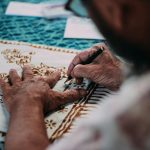Are you struggling to determine the right side of linen fabric? Look no further! This article will guide you through the process step by step.
By understanding the characteristics of linen fabric, identifying the warp and weft threads, examining the texture and finish, observing the selvage edges, and utilizing the burn test method, you’ll be able to confidently distinguish the right side from the wrong side.
Say goodbye to confusion and hello to expertise!
Table of Contents
Understanding the Characteristics of Linen Fabric
To understand the characteristics of linen fabric, you should pay attention to its unique texture and breathability. Linen fabric is known for its distinctive texture, which is coarse yet smooth to the touch. It has a natural luster that gives it a luxurious appearance. The breathability of linen fabric is another notable feature. It allows air to flow freely, making it a great choice for warm weather clothing.
When it comes to linen fabric care tips, it is important to follow the manufacturer’s instructions. Generally, linen should be hand washed or machine washed on a gentle cycle with cold water. It is best to avoid using harsh detergents or bleach, as they can damage the fabric. After washing, linen should be line dried or laid flat to dry.
There are different types of linen fabric available, each with its own unique qualities. Belgian linen is considered to be the finest and most luxurious type of linen. It is known for its exceptional softness and durability. Irish linen is another popular type known for its high quality and smooth texture. French linen, on the other hand, has a slightly more rustic feel and is often used for more casual garments.
Understanding the characteristics of these different types of linen fabric can help you choose the right one for your needs.
Identifying the Warp and Weft Threads
You can easily identify the warp and weft threads by looking closely at the fabric. Analyzing the thread count and identifying the fabric’s natural color variations can help you determine which threads are the warp and which are the weft.
The thread count refers to the number of warp and weft threads per square inch of fabric. By counting the number of threads in both directions, you can determine which threads are running horizontally (weft) and which are running vertically (warp).
In addition to analyzing the thread count, you can also identify the warp and weft threads by examining the fabric’s natural color variations. Linen fabric often has slight variations in color due to the way it is woven. The warp threads, which run vertically, tend to be lighter in color, while the weft threads, which run horizontally, are usually slightly darker. These color variations can be subtle, but by closely inspecting the fabric, you can easily distinguish between the warp and weft threads.
Examining the Texture and Finish
Take a close look at the texture and finish of the fabric to determine its quality and overall appearance. This step is crucial in determining whether the linen fabric is of high quality or not. Here are some key things to consider:
-
Thread count: Check the fabric for its thread count, which refers to the number of threads per square inch of fabric. A higher thread count generally indicates a smoother and more durable fabric. Look closely at the weave and count the number of threads both horizontally and vertically to determine the thread count.
-
Dye variations: Examine the fabric for any variations in dye. High-quality linen fabric should have a consistent color throughout, without any streaks or uneven patches. If you notice any discrepancies in the dye, it may indicate poor quality or improper dyeing techniques.
-
Finish: Pay attention to the finish of the fabric. A high-quality linen fabric will have a smooth and even finish, with no loose threads or rough spots. Run your fingers along the fabric to check for any imperfections or rough textures.
Observing the Selvage Edges
Inspecting the selvage edges will provide important information about the quality and construction of the fabric. When examining the selvage edges, pay attention to the color and pattern. This will help you determine the right side of the linen fabric.
The selvage edges are the finished edges of the fabric that run parallel to the length of the fabric. They are usually more tightly woven and have a different texture compared to the rest of the fabric. By observing the selvage edges, you can spot any inconsistencies or flaws in the fabric, such as loose threads or uneven weaving.
Additionally, the selvage edges often have a different color or pattern than the rest of the fabric. This is because they are usually used as a guide during the manufacturing process. By comparing the selvage edges to the rest of the fabric, you can easily identify the right side. The right side of the fabric is the side that is intended to be seen and is usually more vibrant and detailed.
Utilizing the Burn Test Method
Utilizing the burn test method can help determine the composition of the fabric. By following these steps, you can easily conduct the burn test and analyze the results:
- Prepare a small sample of the fabric you want to test.
- Use a pair of tweezers to hold the fabric sample securely.
- Light a match or a lighter and carefully bring the flame near the fabric.
- Observe the behavior of the fabric as it burns.
The burn test results can provide valuable information about the fabric’s composition. For example, natural fibers like cotton and linen will burn while synthetic fibers like polyester and nylon will melt and form beads.
Although the burn test method is widely used, there are alternative methods available to determine fabric composition. These include using chemical tests or consulting fabric experts who can analyze the fiber content through microscopic examination.
Conclusion
In conclusion, understanding the characteristics of linen fabric is crucial in determining the right side. By identifying the warp and weft threads, examining the texture and finish, and observing the selvage edges, you can easily differentiate between the right and wrong sides.
Additionally, utilizing the burn test method can further confirm your findings. With these techniques, you’ll be able to confidently identify the right side of linen fabric and ensure that your finished project looks its best.
- Does Calico Fabric Shrink? Your Guide to Prevention and Care - June 19, 2025
- How to Properly Wash, Prewash, and Care for Calico Fabric - June 19, 2025
- What Is Calico Fabric? A Complete Guide for Beginners - June 19, 2025



